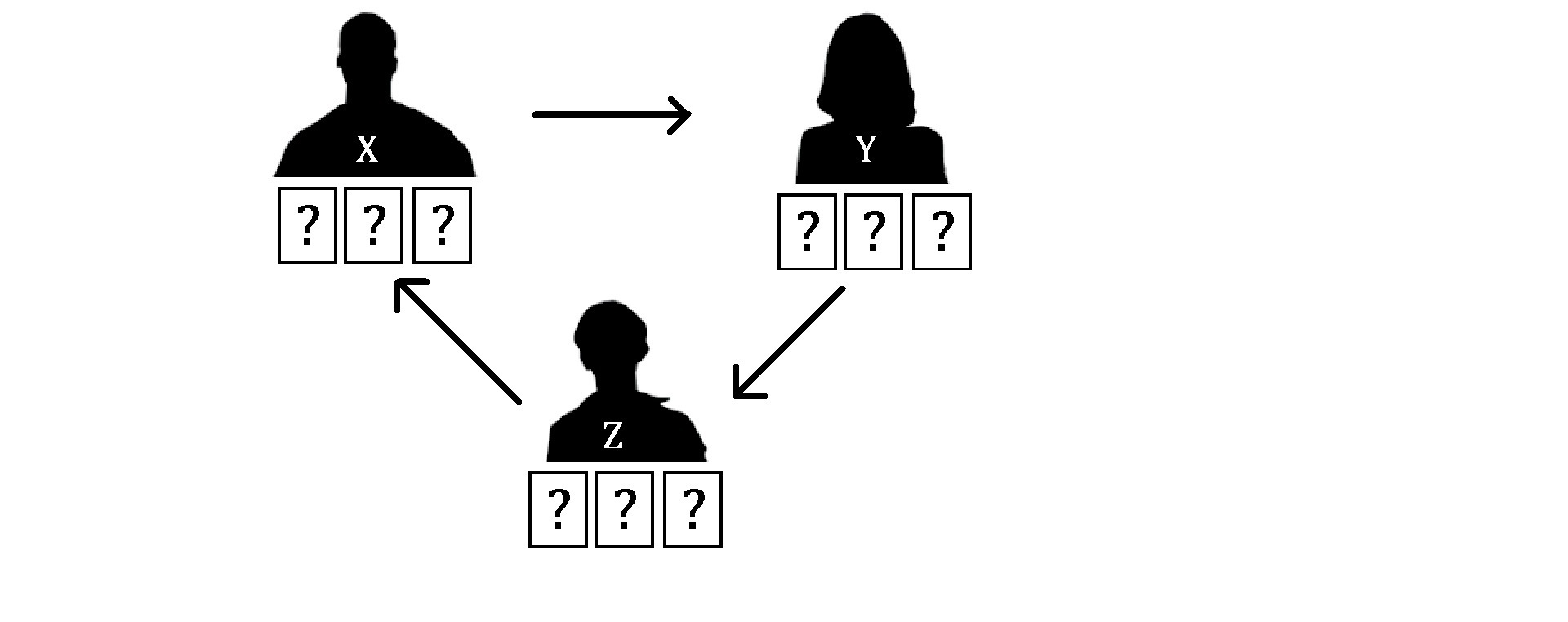Equal Sum Game

Mr. X, Mrs. Y, & Mr. Z were card players, each holding cards in their hands. All of them knew that the number on the card varied from to distinctly, but what they didn't realize was that the sums of numbers they had were all equal among the three of them.
To play this game, each of them would show one of their cards on the table, and whoever had the highest number would win the round. (Assuming was the lowest with no aces.) Taking turns as shown above, after each round ended, the beginner would shift to the next person. (For example, if the first round was X to Y to Z, then the next round would be Y to Z to X and so on.)
The players would play the rounds logically: They would use their highest "trump" card whenever they were absolutely sure they would win. On the other hand, they would opt their "medium" or lower card when they were unsure, and after seeing the opponent's high card, they would discard their lowest card instantly.
With Mr. X starting the game, the resulted winners were Mrs. Y in round #1, Mr. X in round #2, and Mr. Z in round #3 respectively. Interestingly, the sums of the revealed cards in each round were all equal to the original sum held in their hands!
If the alphabets - represented the values of the first to the last cards played respectively, what would be the value of the 9-digit ?
The answer is 492168735.
This section requires Javascript.
You are seeing this because something didn't load right. We suggest you, (a) try
refreshing the page, (b) enabling javascript if it is disabled on your browser and,
finally, (c)
loading the
non-javascript version of this page
. We're sorry about the hassle.
Since the sums of the numbers were equal among the three players, such sum would equal 3 1 + 2 + 3 + 4 + 5 + 6 + 7 + 8 + 9 = 1 5 .
Then there are 2 possible scenarios for these card holders:
( 1 , 5 , 9 ) , ( 2 , 6 , 7 ) , ( 3 , 4 , 8 ) or ( 1 , 6 , 8 ) , ( 2 , 4 , 9 ) , ( 3 , 5 , 7 ) .
Whoever got the 9 -card would play this trump card immediately because he or she knew it was the highest one. In this case, since Mrs. Y won the first round, she had the 9 -card. Similarly, with the same reasoning, Mr. X had the 8 -card and Mr. Z the 7 -card.
Now considering the second scenario, since Mr. X was the beginner and wouldn't play 8 card right away, he would use his "medium" 6 -card, but after Mrs. Y revealed her 9 -card, the sum would definitely exceed 1 5 no matter what Mr. Z played in the first round.
Therefore, only the former scenario applied: Mr. X had ( 3 , 4 , 8 ) ; Mrs. Y ( 1 , 5 , 9 ) ; & Mr. Z ( 2 , 6 , 7 ) .
Thus, Mr. X would start with his "medium" 4 -card → Mrs. Y 9 -card → Mr. Z discarded his 2 card as he knew it was unbeatable. Note that 4 + 9 + 2 = 1 5 .
Then for the second round, Mrs. Y would play her 1 card (keeping her highest for that time) → Mr. Z played his 6 -card as he wasn't sure if Mr. X would have the 8 -card → Mr. X indeed played the 8 -card. Again, 1 + 6 + 8 = 1 5 .
The rest was played as their last cards: 7 → 3 → 5 . Also, 7 + 3 + 5 = 1 5 .
Therefore, the right order played would be 4 9 2 1 6 8 7 3 5 .